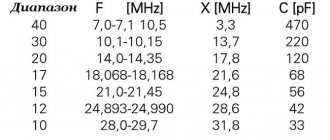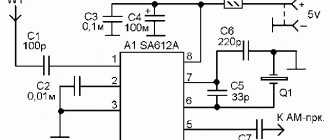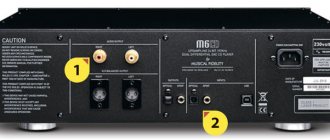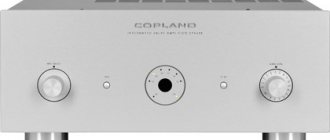LynxStudio Hilo USB Black dual channel DAC/ADC converter
The new Lynx Hilo reference DAC/ADC converter takes the concept and functionality of a two-channel converter and combines the performance of a high-performance DAC/ADC converter with a monitoring control system and headphone preamplifier. Hilo has capabilities and control that have never been available before. New BiLynear™ technology delivers exceptional industry-leading noise and unprecedented transparency. Flexible I/O routing ensures excellent performance in recording, mixing and mastering applications. In addition to Line In and Line Out, Hilo has headphone and monitor outputs, and Hilo also has digital outputs: AES/EBU, coaxial S/PDIF, optical S/PDIF and ADAT, USB interface. Among other advantages of the Lynx Hilo converter is a digital 32-channel mixer. Thanks to its advances, Hilo has headphone preamps, allowing the use of low impedance headphones today. Hilo is the first professional two-channel converter with touch controls, intuitive menus and monitoring system. Various types of level meter indications are available, such as horizontal meters, old-style VU meters, and the “All I/O” option is also available. Various menus allow you to leave the following settings: sample rate, sync source, optical mode, trim analog. The innovative Output Routing mix screen allows you to route any input to any output with full level control. The design, based on FPGA technology, LCD display allows Hilo to combine a large number of different characteristics, functions, and utilities. The converter also has an LSlot expansion slot for optional interfaces, including those still under development. So when you buy a Hilo today, you're getting a device that will continually evolve and evolve to meet your needs in the future.
Features of Lynx Hilo:
- Multifunctional, High Efficiency DAC/ADC Converter
- High quality headphone preamp
- Analog Line In and Out: Balanced XLR with 8 standard trim levels
- Monitor output: two-channel banal TRS with volume control, supporting half-step dB adjustment
- Headphone output: stereo ¼” phone jack with volume control, supporting half-dB step adjustment
- AES/EBU and S/PDIF coaxial outputs
- S/PDIF optional I/O, ADAT I/O also supported
- Touch LCD display (480 x 272 pixels)
- The latest FPGA technology allows you to expand the ability to use the LCD screen for control, diagnostics, monitoring and measurement of parameters
- Proprietary Lynx Studio Technology for eliminating jitter - SynchroLock™
- Power: 110-230V AC or 9-18 Volt DC
- High-speed USB 2.0 interface, compatible with Windows and Mac
- Designed and manufactured in the USA by Lynx Studio Technology, Inc.
Characteristics of Lynx Hilo:
Line A/D input
- THD+N -114dB @1kHz, -1dB(FS, Full Scale), 20kHz filter
- Dynamic Range121 dB, A-weighted, -60 dB(FS, Full Scale)
- Frequency response ± 0.01 dB, 20 – 20 kHz
- Crosstalk -140 dB max. @ 1kHz, -1dB(FS, Full Scale)
Line output D/A
- THD+N -109dB @1kHz, -1dB((FS, Full Scale)), 20kHz filter
- Dynamic Range 121 dB, A-weighted, -60 dB(FS, Full Scale)
- Frequency response ± 0.02 dB, 20 – 20 kHz
- Crosstalk -135 dB max. @ 1kHz, -1dB(FS, Full Scale)
Did you see an error in the description? Select the inaccurate text and press Ctrl+Enter.
MUZMAG.RF - the most music store!
Let's put an end to the pronunciation. The company's founder and chief developer, American engineer Bob Bauman, pronounces Hilo as "hilo", with an emphasis on the first syllable. Most likely borrowed from the resort name of the same name in Hilo, Hawaii.
our exclusive interview with the developers of Lynx Studio Technology in the review of Lynx Studio E22 and Lynx Studio E44 - PCI Express update for L22 and LynxTWO
What's new since the release of Lynx Studio Hilo? In 2017, firmware appeared that changed the appearance of the screen and the entire logic of the device. This does not affect the sound, but it does affect the functions, convenience and overall impression - it increases the interest of potential users. We tried both firmwares, old and new. The new firmware can at least forgive everything for the updated, very beautiful VU meters. Of course, new display options have appeared, as well as new operating modes for standalone use, without a computer. The device is based on FPGA, that is, its functions are completely determined by the current firmware and can be changed to a significant extent.
Lynx Hilo Specifications
| Linear XLR input | |
| Kg+noise | -114 dB |
| Dynamic range | 121 dB |
| frequency response | ± 0.01 dB, 20 - 20 kHz |
| Channel penetration | -140 dB |
| Signal level at full amplitude | +0dBV, +2dBV, +4dBV, +6dBV, +18dBu, +20dBu, +22dBu, +24dBu |
| Linear XLR output (dual mono) | |
| Kg+noise | -109 dB |
| Dynamic range | 121 dB |
| frequency response | ± 0.02 dB, 20 - 20 kHz |
| Channel penetration | -135 dB |
| Signal level at full amplitude | +0dBV, +2dBV, +4dBV, +6dBV, +18dBu, +20dBu, +22dBu, +24dBu |
| Linear TSR output MONITORS | |
| Kg+noise | -107 dB |
| Dynamic range | 121 dB |
| frequency response | ± 0.02 dB, 20 - 20 kHz |
| Channel penetration | -135 dB |
| Signal level at full amplitude | +10 dBV, +24dBu (on-board jumper) |
| Headphone output | |
| Kg+noise | -107 dB |
| Dynamic range | 121 dB |
| frequency response | ± 0.02 dB, 20 - 20 kHz |
| Channel penetration | -130 dB |
| Signal level at full amplitude | +19 dBu |
| Digital inputs/outputs | |
| AES/EBU | Transformer isolation, XLR connectors |
| S/PDIF coaxial | Transformer isolation, RCA connectors |
| S/PDIF optical | stereo |
| ADAT | 8 channels |
| Synchronization | |
| Internal | |
| External | BNC word clock input and output |
| AES/EBU or S/PDIF | |
| Other | |
| AC power | 110 V, 220 V, 30 W |
| On battery | 9-18 DC, 4-pin XLR |
| Consumption | +3.3V @ 630 mA, +12V @ 500 mA |
| LCD screen | color touch screen 480x282 |
| LSlot extension | 32x32 channels |
In addition to the Thunderbolt version of Hilo, you can buy USB or some other one, and later switch to a new connection by simply purchasing an additional interface card and inserting it into the slot inside the device.
Thunderbolt combines PCI Express and DisplayPort interfaces in one cable, and a daisy chain connection is allowed from one TV device to another. It is clear that the PCI Express bus is used here. The bandwidth is 10 Gb/s, which is twice the peak speed of USB3.0. That is, it becomes possible to create an external device that is in no way inferior in speed to the internal one, but without limiting itself in any way in size and power consumption. That is, there is a real benefit from the Thunderbolt connection, it is not here for the sake of chasing fashion.
This is the fastest and most direct connection to a computer today. Any number of channels will pass through this bus in a minimum time, less than 1 ms at 96 kHz operating mode and just over 1 ms at 44/48. It makes no sense to reduce the buffer further, since in modern operating systems the central processor needs to be given time to process data and service applications. There is no theoretical point in updating the buffer more than 1 ms - this is beyond the range of latency recognition by human hearing. When playing an instrument, a delay of less than 10 ms is considered comfortable, and even the most picky musicians no longer feel discomfort at 4 ms. During sound recording, the delay does not play any role; it is compensated by the sequencer. Even if you set a buffer of 1 second, the recording of the part will not be out of sync with the rest of the phonogram - each card tells the recording program the size of the current buffer for precise time synchronization of the track.
Lynx Studio Hilo TB is the world's first Thunderbolt audio interface that works equally well on Windows and Mac OS X computers. We connected it to a Windows computer based on an Intel card with Thunderbolt. Everything worked just fine!
One of the nice features of the Hilo is that the LINE OUT, MONITOR OUT and PHONES outputs are completely independent. The XLR outputs serve two separate DACs in dual mono mode, the TRS and headphone outputs serve two more separate DACs.
The cost of Lynx Studio Hilo TB is about 180 thousand rubles. Many lovers of good sound bought and compared the sound with audiophile brands. Most of those listening did not understand anything or became hostages of the existing cliches about “overly detailed sound”, “overpaying for the screen”, “only for work”. All these reviews are complete nonsense. Lynx Studio Hilo TB can compete with any device for any money. In the top category, it is no longer possible for one DAC to outperform another. Usually the situation is much more complicated. Somewhere the high frequencies are a little more detailed, but the mids and bass are a little blurry. Some DAC may have shortcomings that compensate for the shortcomings of the further path. To make a correct comparison, you need an audio path that is an order of magnitude more accurate and it is desirable to have some kind of reference, that is, a reference point, for all the DACs being compared. This is an extremely difficult task, and in amateur testing it can never be solved. The results are also influenced by the personal preferences of the listeners. Some people like a softer sound, others a harsher one.
We spent two weeks listening to the Lynx Hilo TB. Every day we compared it with a number of devices, and also used all possible expensive speakers and headphones to reveal the character of Hilo. The main conclusion we reached is the following. As a high-quality DAC, Hilo's sound is neutral in timbre and maximizes detail in the midrange. You can find more interesting DACs for HF, with a wider stereo effect, but in general, in the overall assessment, the sound of Hilo is close to ideal. The recordings reveal something that remains somewhat hidden in the case of other DACs. At the same time, there is no harshness or unpleasant moments that interfere with aesthetic perception, which the mass listener is latently waiting for. Everything is fine with the music, everything is in its place, you want to listen to the recordings without stopping.
How does Lynx Hilo compare to Hi-End DACs? Since the listener’s preference is primary when listening to music, it is necessary to listen personally and draw conclusions. The culture of many listeners favors audiophile DACs with an exotic sound character. And someone selects equipment so as to compensate for the excessive brightness or dullness of the sound of acoustics or headphones. However, you can be sure that Lynx Hilo holds up well against any device, regardless of price. If you need sound with a dense mid-frequency range, with very high detail and panorama, without harshness or distortion, you will like the Lynx Hilo.
Could you ask for better sound? It is quite possible, but only without any reservations that, unfortunately, this DAC has problems with such and such a range or there is a slight coloration on the HF. According to the chief developer, the process of creating a new product takes a lot of time. On average, Lynx releases products once every 5 years. At this time, engineers make prototypes on all existing DACs with various options for the circuits that serve them. At the time of Hilo's creation, there were enough other DACs, but the dual mono CS4398 solution was chosen, which made it possible to obtain record low distortion among all existing devices based on this converter chip. Distortions are lower than in the manufacturer's datasheet.
Hilo's internals are very interesting. Pulse power supply has caused a lot of discussion. It is not visible in the photo, it is made on a separate board, located under the main one. It should be taken into account that even the most expensive Hi-End DACs now have switching power supplies, and no one complains about their sound. This means that a linear power supply with a huge toroidal transformer is not a necessary condition today. Lynx Aurora has a huge torus, electrolytes 4 cm in diameter and a linear power supply. The performance is ultimately lower than that of the Lynx Hilo. By the way, we separately hired a specialist who powered the Lynx Hilo from an external laboratory power supply. There were no changes in sound or measurements. You can safely power the device from 220V. The issue with the quality of the power supply has been resolved.
Headphone output is implemented based on LME49600 in each channel. This is a 250 mA current buffer with 0.00003% distortion + noise at 3Vrms. It is preceded by the LME49720 op-amp with very low distortion, Kg+noise 0.00003%. This combination is recommended in the LME49600 documentation, and the subjective sound quality confirms that this is a very good recommendation.
4 pieces DAC CS4398, op amp OPA1612A 0.000015%, OPA1632 distortion 0.000022%, solid capacitors.
By the way, not only the DAC is connected according to the dual mono scheme, but the ADC too! This results in a 3 dB reduction in noise and distortion.
One of the most interesting features is that the level of the MONITORS and PHONES outputs is adjusted in analogue form with fine steps in the PGA4311UA volume control. It has (exactly and only in the UA version) very high quality, Kg + noise 0.0002%. Channel separation greater than 130 dB. Dynamic range 120 dB. You can also adjust digitally by switching the ANALOG button on the mixer to DIGITAL.
The input and output levels are adjusted in steps by a large number of relays on the board. The following values are available: +0dBV, +2dBV, +4dBV, +6dBV, +18dBu, +20dBu, +22dBu, +24dBu.
Lynx Hilo has been in development for over three years. So many things are provided that it turns out to be an exemplary device! Various interesting opportunities are laid down for the 10 years ahead.
The new firmware introduces a system of presets. You can choose the one you need depending on whether you are using Hilo with a computer or standalone. Using Hilo with a computer makes SO MUCH SENSE. Thus, the internal clock of the device is used, and the playback speed is transferred to the computer. This is the most preferred and comfortable mode. In the case of external AES or other digital signal signal, it will take a couple of minutes to adjust the internal frequency to the speed of the external stream. Further playback will be in the best quality, but when changing the frequency, you will again have to wait a little.
We used the latest available firmware 8.0.
The most impressive type is analog pointer VU meters. They show the current volume of the selected channel in real time. That is, they are not for beauty, but actually represent exactly the same as their analog prototypes. This is not a decoration, it is a practically usable level indication.
True multi-segment picmeters are also present. Inertia parameters can be set.
Although the screen does not have very many dots, since you have to look at it from half a meter maximum, the graininess is not annoying. It is much more valuable that it is large and quite informative. The viewing angle is approximately 100 degrees.
In addition to the arrow picmeters, the 20-band RTA loudness analyzer mode is useful.
The signal routing tabs allow you to select which outputs will go to which inputs.
Device: ASIO Lynx Device: ASIO LynxFeatures: Input channels: 16 Output channels: 16 Input latency: 339 Output latency: 273 Min buffer size: 32 Max buffer size: 8192 Preferred buffer size: 256 Granularity: -1 ASIOOutputReady — supported Sample rate: 8000 Hz — supported 11025 Hz — supported 16000 Hz — supported 22050 Hz — supported 32000 Hz — supported 44100 Hz — supported 48000 Hz — supported 88200 Hz — supported 96000 Hz — supported 176400 Hz — supported 192000 Hz — supported 352800 Hz — not supported 384000 Hz — not supported Input channels: channel: 0 (Lynx Hilo Record 01) — Int32LSB channel: 1 (Lynx Hilo Record 02) — Int32LSB channel: 2 (Lynx Hilo Record 03) — Int32LSB channel: 3 (Lynx Hilo Record 04) — Int32LSB channel: 4 (Lynx Hilo Record 05) — Int32LSB channel: 5 (Lynx Hilo Record 06) — Int32LSB channel: 6 (Lynx Hilo Record 07) — Int32LSB channel: 7 (Lynx Hilo Record 08) — Int32LSB channel: 8 (Lynx Hilo Record 09) - Int32LSB channel: 9 (Lynx Hilo Record 10) - Int32LSB channel: 10 (Lynx Hilo Record 11) - Int32LSB channel: 11 (Lynx Hilo Record 12) - Int32LSB channel: 12 (Lynx Hilo Record 13) - Int32LSB channel: 13 (Lynx Hilo Record 14) — Int32LSB channel: 14 (Lynx Hilo Record 15) — Int32LSB channel: 15 (Lynx Hilo Record 16) — Int32LSB Output channels: channel: 0 (Lynx Hilo Play 01) — Int32LSB channel: 1 (Lynx Hilo Play 02) - Int32LSB channel: 2 (Lynx Hilo Play 03) - Int32LSB channel: 3 (Lynx Hilo Play 04) - Int32LSB channel: 4 (Lynx Hilo Play 05) - Int32LSB channel: 5 (Lynx Hilo Play 06) — Int32LSB channel: 6 (Lynx Hilo Play 07) — Int32LSB channel: 7 (Lynx Hilo Play 08) — Int32LSB channel: 8 (Lynx Hilo Play 09) — Int32LSB channel: 9 (Lynx Hilo Play 10) — Int32LSB channel: 10 ( Lynx Hilo Play 11) — Int32LSB channel: 11 (Lynx Hilo Play 12) — Int32LSB channel: 12 (Lynx Hilo Play 13) — Int32LSB channel: 13 (Lynx Hilo Play 14) — Int32LSB channel: 14 (Lynx Hilo Play 15) — Int32LSB channel: 15 (Lynx Hilo Play 16) — Int32LSB
The device does not support 384 and 768 kHz modes.
From firmware 5.0 the DSD format is supported via DoP 1.1. That is, you need to send a bit-by-bit signal inside a PCM frame, where there will be a special marker in the first 8 bits. Various specialized players, such as Audirvana, JRiver, Foobar2000, can do this. The device must be set to 176.4 kHz mode. The pixel meters do not work during playback and the DSD logo appears on the screen. The signal is output to all possible DACs of the device at once, since no adjustments or signal redirections for DSD can be applied.
As we can see, when installing a Thunderbolt board, the card has 16 channels for input and output.
Measurements in RMAA PRO input to output were carried out by connecting a long XLR Cordial cable close to a running computer. This did not cause any problems.
| Device under test | Lynx Hilo |
| Operating mode | 24-bit, 44 kHz |
| Audio Interface | ASIO |
| Signal route | External loopback (line-out - line-in) |
| RMAA version | 6.4.1 PRO |
| Filter 20 Hz - 20 kHz | ON |
| Signal normalization | ON |
| Level change | -0.0 dB / -0.0 dB |
| MONO mode | OFF |
| Calibration signal frequency, Hz | 1000 |
| Polarity | correct/correct |
| Frequency response unevenness (in the range 40 Hz - 15 kHz), dB | +0.00, -0.02 | Great |
| Noise level, dB (A) | -119.4 | Great |
| Dynamic range, dB (A) | 119.3 | Great |
| Harmonic distortion, % | 0.0003 | Great |
| Harmonic distortion + noise, dB(A) | -106.5 | Great |
| Intermodulation distortion + noise, % | 0.0005 | Great |
| Interpenetration of channels, dB | -120.5 | Great |
| Intermodulation at 10 kHz, % | 0.0005 | Great |
| Overall rating | Great |
Detailed RMAA results for 24bit 44kHz, 24bit 48kHz, 24bit 96kHz, 24bit 192kHz modes.
The frequency response is an absolutely straight line.
There are no interferences in the noise spectrum. Noise level -119 dB. According to the passport -121 dB. The input and output noise added up, so 119 dB.
The dynamic range test shows no signal interference.
The harmonic distortion test gives an impressive 0.0003%.
For channel penetration and intermodulation distortion, the result windows are empty—values below -100 dB.
Measurements were taken with the level switch position at +24 dBu. The figures for record low distortion confirm the manufacturer's data sheets! Let us remind you that when testing the internal Lynx E44 card, we almost did not achieve the declared signal/noise and super-flat spectrum due to some interference inherent in our PC. The Lynx Hilo external solution combines both the speed of the internal bus and the quality of the external device!
It is believed that high numbers are obtained solely due to the high signal level. Therefore, we also carried out measurements at maximum input sensitivity.
| Device under test | Lynx Hilo |
| Operating mode | 24-bit, 44 kHz |
| Audio Interface | ASIO |
| Signal route | External loopback (line-out - line-in) |
| RMAA version | 6.4.1 PRO |
| Filter 20 Hz - 20 kHz | ON |
| Signal normalization | ON |
| Level change | 0.1 dB / 0.1 dB |
| MONO mode | OFF |
| Calibration signal frequency, Hz | 1000 |
| Polarity | correct/correct |
| Frequency response unevenness (in the range 40 Hz - 15 kHz), dB | +0.00, -0.02 | Great |
| Noise level, dB (A) | -112.7 | Great |
| Dynamic range, dB (A) | 112.6 | Great |
| Harmonic distortion, % | 0.0005 | Great |
| Harmonic distortion + noise, dB(A) | -102.4 | Great |
| Intermodulation distortion + noise, % | 0.0009 | Great |
| Interpenetration of channels, dB | -113.9 | Great |
| Intermodulation at 10 kHz, % | 0.0008 | Great |
| Overall rating | Great |
As we can see, even at low voltage, only +0dBu, all parameters are simply excellent. We lowered the volume by 24 dB, so we had to use an analog amplifier to digitize the Hilo full-amplitude. The noise increased by only 6 dB, instead of 24 dB. Thus, you can accurately select the sensitivity of the Hilo inputs and outputs and not adjust the digital volume at all, giving 100% of the bit grid for high-quality digitization and playback in bit mode! This is a very subtle feature of Lynx Hilo, and it is a huge technical advantage for studio work.
Interestingly, the developers have also provided for remote control of the panel from the iPad. To do this, Lynx Hilo must be connected to your computer.
As we can see, the roundtrip latency is 3.72 ms. So only for output 1.86 ms
If you put the card in 96 kHz mode, the delay will be half that value. 1.64 ms roundtrip latency. Only for 0.82ms output! That is, the latency is even lower than that of many internal boards. This is a consequence of the PCI Express bus and the right hardware, which does not delay the signal anywhere.
The buffer size is configurable. The value 256 is quite sufficient for any application.
Lynx Hilo TB left us with the most positive impression. This is a very successful, well-thought-out device in all respects, indispensable in any commercial studio. Everything here is done for the sake of the quality of digitization and reproduction - and this quality is achieved both during measurements and when evaluating in monitors and headphones. The only thing stopping me from buying is the fairly high price of the Lynx Hilo by the standards of mass-produced equipment. For studio equipment, this is not the price at all, but three kopecks.
On the Internet, someone complained that there was no guitar input and microphone input, that there was no MIDI input/output. But listen up, friends, this is a mastering-grade device! It’s unlikely that anyone will be happy if a cheap microphone/guitar pre is attached to an excellent reference DAC and ADC. And if you screw in something that’s not a penny, it’s immediately an unnecessary increase in price by +$1000. The studio has all sorts of equipment, different presets for different microphones, different guitars. From companies that have been working on this topic for 20 years and are able to offer a lot of interesting things. But the highest quality digitization and quality control path is something other manufacturers have a problem with. So it can only be welcomed if all unnecessary husks are thrown out of the device, as an attribute of inexpensive devices.
You could even say that Lynx Hio is already equipped with a second independent line output with smooth analogue adjustment, and an independent, powerful, high-quality headphone output. Unlike the first generation Aurora, Lynx Hilo has not two fixed levels, but much more - it is easier to connect any existing equipment, from studio to home.
Don't forget that this is the first Thunderbolt device that works great not only with Mac, but also with PC! We tried just such a connection - everything works fine. Expandability is also amazing, with a Dante interface card already available. This means that the device can be placed at least 20 meters from the computer, which USB or Thunderbolt will not allow.
Lynx Studio Hilo card was provided for testing by the distribution center PROAUDIO.RU
Specifications:
- Line A/D input
- THD+N -114dB @1kHz, -1dB (FS, Full Scale), 20kHz filter
- Dynamic Range121 dB, A-weighted, -60 dB (FS, Full Scale)
- Frequency response ± 0.01 dB, 20 - 20 kHz
- Crosstalk -140 dB max. @ 1kHz, -1dB (FS, Full Scale)
- Line output D/A
- THD+N -109dB @1kHz, -1dB ((FS, Full Scale)), 20kHz filter
- Dynamic Range 121 dB, A-weighted, -60 dB (FS, Full Scale)
- Frequency response ± 0.02 dB, 20 - 20 kHz
- Crosstalk -135 dB max. @ 1kHz, -1dB (FS, Full Scale)
Main Features and Specifications:
- Multifunctional, High Efficiency DAC/ADC Converter
- High quality headphone preamp
- Analog Line In and Out: Balanced XLR with 8 standard trim levels
- Monitor output: two-channel banal TRS with volume control, supporting half-step dB adjustment
- Headphone output: stereo? phone jack with volume control, supporting adjustment in half dB steps
- AES/EBU and S/PDIF coaxial outputs
- S/PDIF optional I/O, ADAT I/O also supported
- Touch LCD display (480272 pixels)
- The latest FPGA technology allows you to expand the ability to use the LCD screen for control, diagnostics, monitoring and measurement of parameters
- Proprietary Lynx Studio Technology for eliminating jitter - SynchroLock™
- Power: 110-230V AC or 9-18 Volt DC
- High-speed USB 2.0 interface, compatible with Windows and Mac
- Designed and manufactured in the USA by Lynx Studio Technology, Inc.











